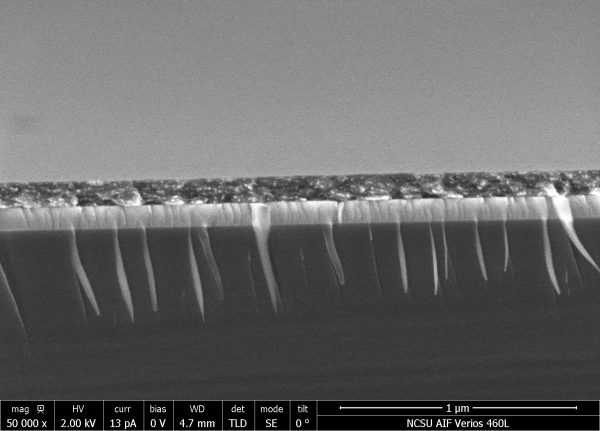 Amanda Volk is a third year PhD student in the Department of Chemical and Biomolecular Engineering and is advised by Dr. Gregory Parsons. Her work is supported by The Center for Dielectrics and Piezoelectrics (CDP). After graduation, she plans to continue a career of collaboration and innovation through working in industrial research and development. From her academic and industrial experience, she also would like to work for a STEM education nonprofit which aims to close the gap in STEM benchmarks between the southern United States and the national average.
Amanda Volk is a third year PhD student in the Department of Chemical and Biomolecular Engineering and is advised by Dr. Gregory Parsons. Her work is supported by The Center for Dielectrics and Piezoelectrics (CDP). After graduation, she plans to continue a career of collaboration and innovation through working in industrial research and development. From her academic and industrial experience, she also would like to work for a STEM education nonprofit which aims to close the gap in STEM benchmarks between the southern United States and the national average.
Outside of work, she enjoys running her cat’s Instagram and advocating for special needs rescue animals.
What primary instrument(s) are you using for your research and what do you like about it?
My project is heavily based on results from X-ray photoelectron spectroscopy (SPECS system with PHOIBOS 150 analyzer), the Rigaku SmartLab X-ray diffractometer, and the FEI Verios 460L field emission scanning electron microscope. I particularly like the Verios SEM system. Effectively seeing submicron features of my substrates and mapping their elemental composition bridges the gap between my reactor parameters and film properties.
What have you been researching?
My research focus is in the field of molecular layer deposition (MLD). Analogous to ALD, molecular layer deposition is the deposition of organic thin films through sequential, self-limiting surface reactions. Currently, I am developing oxidative-MLD (oMLD) processes to deposit thin films of conductive polymers, specifically PEDOT. Through this research, our lab has developed a new understanding of oxidative polymerization chemistry as well as conjugated polymer thin film nucleation and growth. So far, we have seen record breaking conductivities at low deposition temperatures. My research also extends into studying infiltration and growth of PEDOT into high surface area tantalum anodes to characterize the effects of processing parameters on growth mechanisms and kinetics.
How is your research impacting the community?
Even though PEDOT is one of the most widely used intrinsically conductive polymers, it is relatively new to oMLD. A low temperature oMLD process may integrate highly conductive, conformal PEDOT into high aspect ratio, temperature sensitive substrates. These include biomedical device components or smart-textiles. In addition to these implications, my over-arching goal is to use a new fundamental understanding of MLD to develop high performance polymer thin films for electronic devices ranging from consumer electronics to organic photovoltaics.
What have you learned from your experience at AIF?
From my experience at AIF I have learned to ask as many questions as possible about analytical techniques. As my understanding about instrument theory and operation has improved, so has my understanding of what formally may have been erroneous results from my own experiments and even literature.
Best thing about AIF in 5 words or less?
Incredible staff and instruments!
Is there a staff member at AIF that has helped you?
With all of the instruments I have used at AIF I have received enormous help. Staff members who have trained and aided me with their expertise include Roberto Garcia, BB Chung, Elaine Zhou, Fred Stevie, Toby Tung, and Chuck Mooney. Thank you all very much!
